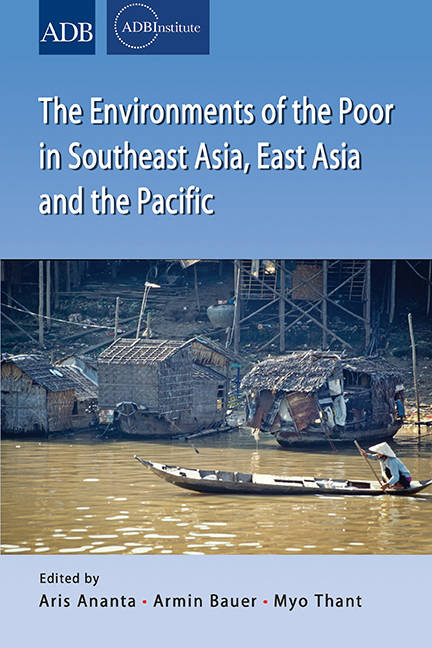Book contents
- Frontmatter
- Contents
- Preface
- List of Contributors
- Part I OVERVIEW
- Part II EAST ASIA (People's Republic of China and Republic of Korea)
- Part III PACIFIC ISLANDS
- Part IV MAINLAND SOUTHEAST ASIA (Cambodia, Thailand, Vietnam)
- Part V ARCHIPELAGIC SOUTHEAST ASIA (Indonesia, Malaysia, Philippines)
- 13 The Political Economy of Environmental Policy in Indonesia
- 14 Prospering in Environmental Degradation: An Illustration from an Upland Area, South Kalimantan, Indonesia
- 15 Making a Living in the Face of Environmental Change: A Case in an Indigenous Community in Sarawak, Malaysia
- 16 The Response of Rural Coastal Households to Typhoon Milenyo in the Philippines
- 17 Life Along Manila's Flooding Rivers
- 18 Quantifying the Health Risks from Pathogens in the Flood Water in Metro Manila
15 - Making a Living in the Face of Environmental Change: A Case in an Indigenous Community in Sarawak, Malaysia
from Part V - ARCHIPELAGIC SOUTHEAST ASIA (Indonesia, Malaysia, Philippines)
Published online by Cambridge University Press: 21 October 2015
- Frontmatter
- Contents
- Preface
- List of Contributors
- Part I OVERVIEW
- Part II EAST ASIA (People's Republic of China and Republic of Korea)
- Part III PACIFIC ISLANDS
- Part IV MAINLAND SOUTHEAST ASIA (Cambodia, Thailand, Vietnam)
- Part V ARCHIPELAGIC SOUTHEAST ASIA (Indonesia, Malaysia, Philippines)
- 13 The Political Economy of Environmental Policy in Indonesia
- 14 Prospering in Environmental Degradation: An Illustration from an Upland Area, South Kalimantan, Indonesia
- 15 Making a Living in the Face of Environmental Change: A Case in an Indigenous Community in Sarawak, Malaysia
- 16 The Response of Rural Coastal Households to Typhoon Milenyo in the Philippines
- 17 Life Along Manila's Flooding Rivers
- 18 Quantifying the Health Risks from Pathogens in the Flood Water in Metro Manila
Summary
Malaysia is divided into thirteen states and three federal territories. Sarawak, located on the island of Borneo, is the largest state in Malaysia. It covers 124,450 square kilometres. Sarawak is richly endowed with natural resources, especially liquefied natural gas, petroleum, and rainforest. Its economy has historically been dominated by the primary sectors (agriculture, forestry, mining, and quarrying), mostly agriculture. But in line with the federal government's policy of economic growth through industrialization, the state government began promoting secondary and tertiary sectors in the 1970s (Kasim 1990). Sarawak was transformed from a poor backwater to a vibrant and industrializing state. By international standards, the level of poverty in Sarawak is now quite low. In 2009, 5.3 per cent (27,100 households) in Sarawak were found living in poverty and 1.0 per cent in extreme poverty. The national overall incidence of poverty and extreme poverty were 3.8 per cent and 0.7 per cent, respectively (EPU 2013). The incidence of poverty is higher in the rural areas.
Parts of the transformative process, such as the Bakun hydroelectric dam, commercial agriculture, and logging, have required clearing parts of the rainforest (Ichikawa 2007). Development projects not only caused a dwindling of the rainforest, but also the degrading of what remains. The primary economic value of Sarawak's rainforest has been as a source of income for the state through the exports of timber and its timberbased products. Timber industries have brought substantial earnings to Sarawak. In 2008, timber products constituted 9 per cent (RM7.9 billion) of the total export earnings of the major commodities in Sarawak though there was a slight drop in the total export earnings of timber products to RM6,698,067 in 2009, followed by a marginal increase to RM7,354,341 in 2010 (Sarawak Timber Industry Development Corporation 2011). The rainforest is a source of raw material for the residents of many of the rural communities of the interior (for rattan baskets and mats, and wooden furniture), and a source of wild boar and wild vegetables for food.
- Type
- Chapter
- Information
- Publisher: ISEAS–Yusof Ishak InstitutePrint publication year: 2013

